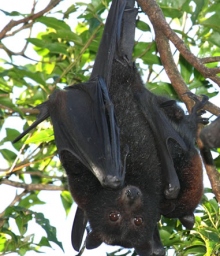Black flying-fox
Pteropus alecto
- Black flying-foxes were first reported roosting in Sydney in the summer of 2006 – 2007
- Black flying-foxes are the largest species of flying-fox in Australia
- They can fly at 35 – 40 kilometres per hour and may travel over 50 kilometres from their camp to a feeding area
- Large communal day-time camps are found in mangroves, paperbark swamps or patches of rainforest, often with grey-headed flying-foxes
- Bats fly out at dusk to feed on rainforest fruits as well as nectar and pollen from flowering eucalypts, turpentines, paperbarks and banksias
- When native foods are scarce, particularly during drought, they take fruit from orchards such as mangoes
Distinguishing between black and grey-headed flying-foxes
The two species are roughly the same size. Check the colour. However individuals of both species can have large variations in colouring, so if in doubt, look at the legs and collar.
Colour –
Generally, the black flying-fox is darker, almost jet black, with little or no lighter collar.
The grey-headed flying-fox is lighter coloured, typically grey, and usually has a brownish-red collar encircling its neck.
Legs –
Greys’ legs are furred to the ankle;
Blacks’ leg fur on the inside of their leg stops at their knees
Collars –
Greys’ collars encircle their neck
Blacks’ collars are either non-existent or just on the back of their necks
For more information about black flying-fox:
Australian Museum
View or download this article by Tim Pearson about black flying-foxes in Sydney

